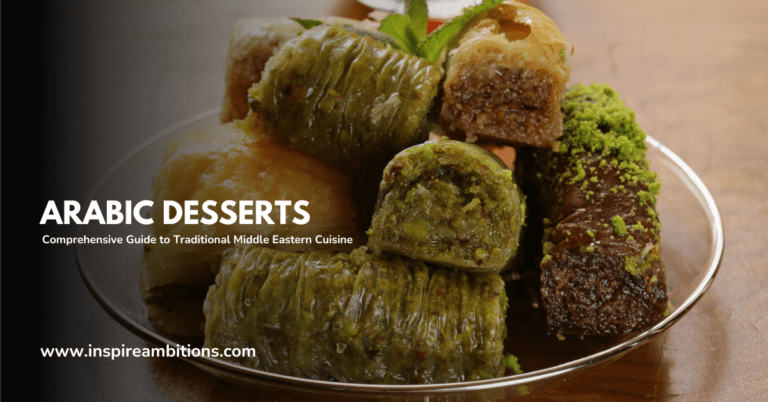আরবি রাইস - এই মধ্যপ্রাচ্যের প্রধান প্রধানের জন্য একটি ব্যাপক গাইড
Arabic rice, also known as rice with vermicelli, is a traditional Middle Eastern dish that has become a staple in homes and restaurants across the region. This tasty and versatile dish is typically served as a side to various meat dishes, such as shawarma or kafta, while also being used as a foundation to accompany diverse stews.
The inclusion of vermicelli not only adds texture but also elevates the flavours, making this rice preparation a delightful culinary experience.
To create this delicious and aromatic dish, start by toasting vermicelli noodles until they achieve a golden-brown colour, taking care to stir constantly to prevent burning.
Then, mix the rice with the noodles, coating the grains in oil to ensure they remain separate and fluffy. For maximum flavour, you can also use chicken stock as a cooking liquid. The result is a fragrant, flavourful, and tantalising concoction that complements a variety of main dishes.
Throughout the Middle East, different countries and regions offer their unique spin on this classic rice dish. Variations such as Kabuli Pulao, Koshari, and Kabsa showcase the versatility of Arabic rice, incorporating distinctive ingredients and flavours.
These adaptations not only reflect the rich culinary traditions of the region, but also the ability of a simple rice dish to adapt, evolve, and delight taste buds across borders.
History of Arabic Rice
The origins of Arabic rice can be traced back to the Abbasid Caliphate when methods of cooking rice that resemble modern styles of pilaf first spread through a vast territory from Spain to Afghanistan. The rice dishes eventually reached a wider world, thanks to the proliferation of culinary techniques and cultural exchanges.
Arabic rice, or rice with vermicelli, is a traditional preparation of rice in the Middle East. This variant of the simpler cooked rice recipe includes the addition of lightly toasted vermicelli. The cooking method, known as pilaf, results in a rice dish that is fluffy, light, and non-sticky.
ভিতরে আরব বিশ্ব, there is no specific name for this way of preparing rice, as it is considered the basic method of cooking rice.
With time, regional variations of Arabic rice emerged, utilising locally available ingredients and flavours. For example, kabsa, an Arab mixed rice dish originating from Yemen, is commonly regarded as a national dish in all the countries of the Arabian Peninsula.
As the popularity of Arabic rice grew, so did its influence on other cuisines. An almond-based dessert called lauzinaj, described as the “food of kings” and “supreme judge of all sweets”, entered medieval European cuisine via Andalusian influences, returning Crusaders, and Latin translations of cookery books.
In summary, the history of Arabic rice is rooted in the ancient culinary traditions of the Middle East. The widespread adoption of rice cooking techniques, regional variations, and cultural exchanges contributed to the development and popularity of Arabic rice dishes that are enjoyed today.
How to Prepare Arabic Rice?
Choosing and Preparing the Ingredients
To prepare Arabic Rice, you need to select the right ingredients to ensure the taste and texture are authentic. Typically, Arabic Rice includes long-grain rice, such as Basmati, and Vermicelli pasta. Some variations use ground beef or chicken.
First, rinse the long-grain rice until the water runs clear. This step removes any excess starch and prevents the rice from being overly sticky.
Next, toast the Vermicelli in a bit of olive oil or butter until golden brown, which adds a nutty flavour and improves the texture. If you decide to add ground meat, season it with garlic powder, ground cinnamon, and allspice for the traditional taste.
Cooking Process
Once you have all the ingredients prepared, it’s time to start cooking the Arabic Rice. Follow these steps to achieve the best results:
- Heat a large pot or non-stick pan with some olive oil or butter over medium heat.
- Add the toasted Vermicelli and sauté for a minute or two.
- Add the washed rice to the pot, stirring it in with the Vermicelli to ensure even distribution.
- Pour in the required amount of chicken stock or water. As a general guideline, use a 1:1.5 ratio of rice to liquid for the ideal texture.
- Season your rice mixture with a pinch of salt, if desired.
- Bring the pot to a boil, then reduce the heat to low, and cover the pot with a tight-fitting lid.
- Allow the rice to cook for 15-20 minutes, or until all the water is absorbed, and the rice is tender but not mushy.
- If you’re using ground meat, you can cook it separately, as directed in the search results, and mix it into the cooked rice at the end of the process.
Arabic Rice is an ideal side dish to complement Middle Eastern main courses. Ensure you choose high-quality ingredients and follow the steps carefully to enjoy the authentic flavour and texture characteristic of this delicious dish.
জনপ্রিয় আরবি চালের খাবার
Arabic rice dishes are a staple in Middle Eastern cuisine and offer a variety of flavours and textures. In this section, we will explore three popular Arabic rice dishes: Maklouba, Kabsa, and Sayadiya.
মাকলাউবা
Maklouba, meaning “upside-down” in Arabic, is a traditional dish showcasing layers of rice, vegetables, and meat. Common ingredients include:
- বাসমতী চাল
- Aubergine (eggplant)
- Cauliflower
- Carrots
- পেঁয়াজ
- Your choice of meat, such as chicken or lamb
- Spices, such as cinnamon, allspice, cardamom, and turmeric
To prepare Maklouba, cook the vegetables and meat with the spices before layering them with partially cooked rice in a deep pot. Once all the layers are arranged, the dish is cooked for an additional period, allowing the flavours to meld together. The pot is then inverted onto a large serving platter, revealing the beautifully layered dish.
কাবসা
Kabsa, originating from Saudi Arabia, is a spiced rice dish often cooked with meat, such as chicken, lamb, or even camel. The main components of Kabsa include:
- দীর্ঘ শস্য ধান
- Meat (chicken, lamb, or other options)
- Vegetables, such as carrots, tomatoes, and onions
- A blend of spices, such as black pepper, cumin, coriander, and saffron
- Nuts and raisins for garnish
The dish is prepared by sautéing the vegetables and meat with spices, then adding the rice and water, allowing them to cook together. The rice absorbs the flavours, creating a fragrant and flavourful meal.
Sayadiya
Sayadiya, also known as fisherman’s rice, is a Lebanese dish that combines spiced rice with fish. The dish primarily features:
- White fish, such as cod or tilapia
- বাসমতী চাল
- Onions
- Vegetables, such as bell peppers and tomatoes
- Spices, including cumin, paprika, and cinnamon
To make Sayadiya, the fish is first marinated in a blend of spices, and then pan-fried. The rice is cooked in a separate pot with caramelised onions and tomato sauce, infusing it with rich flavours. The fish is then placed atop the rice and served alongside a garnish of fried almonds, pine nuts, or chopped parsley.
Each of these popular Arabic rice dishes showcases the versatility of rice and the diverse flavours of Middle Eastern cuisine. Enjoy trying these delicious meals and appreciate the unique taste of each dish.
Nutritional Value of Arabic Rice
Arabic rice, also known as rice with vermicelli, is a traditional preparation of rice in the Middle East. It consists of long-grain rice and lightly toasted vermicelli noodles. You’ll find that this dish not only offers a unique taste and texture but also provides a variety of nutrients.
In a typical homemade serving of Arabic rice (approximately 94.1 grams), you can find approximately 281 calories. The majority of these calories come from carbohydrates, making up around 84% of the total calories (57.8g carbs).
Protein accounts for about 10% of the caloric content (6.7g protein), with the remaining 6% being attributed to fat (1.9g fat).
In addition to the basic macronutrients, Arabic rice also has some fibre and minerals. The fibre in Arabic rice mainly comes from whole grain rice, as the bran and germ remain intact. Fibre is essential for your digestive health, and rice can contribute to your daily fibre intake.
Here is a breakdown of the nutritional content per 94.1g serving of Arabic rice:
- Calories: 281 Cal
- Carbohydrates: 57.8g (84%)
- Fat: 1.9g (6%)
- Protein: 6.7g (10%)
- Fibre: Varies depending on rice type (more in whole grain rice)
- Sodium: 2297mg
Please remember that specific nutritional values may differ depending on the ingredients and preparation method used. Arabic rice can be prepared in various ways with different ingredients, which can influence the final nutritional content. Alterations such as using healthier oils, adding vegetables, or using alternative rice types (like brown rice) can improve the nutritional value of the dish.
Pairing Ideas and Serving Suggestions
When it comes to enjoying Arabic rice dishes, there are numerous ways you can enhance the dining experience through versatile pairings and serving suggestions. As a food enthusiast, these ideas can help you elevate your meals and impress your guests with your culinary expertise.
প্রথমত, complementing your rice dishes with protein is a winning combination. For non-vegetarian options, consider grilled or baked meats like chicken, beef, or lamb, which perfectly match the flavours of Middle Eastern rice dishes such as Kabuli Pulao or Kabsa. For vegetarian alternatives, try adding chickpeas, lentils, or mixed vegetables to your rice like Koshari or Mujadara.
Secondly, remember that sauces and dips can add depth of flavour to your rice dishes. Traditional Middle Eastern options like hummus, tahini, baba ganoush, or tzatziki can contribute refreshing, rich and tangy notes to your meals. Don’t be afraid to experiment with other sauces too, such as a yoghurt and mint dip or a spicy tomato-based sauce.
Another idea is to serve your Arabic rice dishes alongside fresh salads. Middle Eastern-inspired salads featuring ingredients like tomatoes, cucumbers, onions, and parsley, often dressed with lemon juice and olive oil, can provide a delightful contrast to the rich and aromatic rice dishes. A classic choice is the popular Fattoush or Tabbouleh.
Finally, consider enhancing the texture and flavour of your Arabic rice dishes with additional garnishes. Options like toasted pine nuts, almonds, raisins, or fried onions can add a pleasant crunch and an extra layer of taste to your meal. Experiment with different garnishes to discover which combinations suit your preferences best.
Remember, there is no one-size-fits-all approach to pairing and serving Arabic rice dishes. It’s about exploring various elements and creating a meal that caters to your taste buds. So, don’t be afraid to get creative and discover new combinations that delight your palate.
Tips and Tricks for Perfect Arabic Rice
To ensure that your Arabic rice comes out perfectly, follow these helpful tips and tricks:
- Choose the right rice: Basmati rice works best for this dish, as it produces fluffy, separate grains when cooked. Use high-quality rice, and rinse it well before adding it to the pot to remove excess starch.
- Toast the vermicelli: To get a rich, nutty flavour and perfect texture, toast the vermicelli in butter or ghee until it turns dark brown. Ensure even toasting by continuously stirring the vermicelli.
- Cooking method: Add the washed rice to the toasted vermicelli and cook with water and salt. Begin with a high heat until the water reaches boiling point, then lower the heat and cover the pot. Cook for about 20 minutes and avoid opening the lid during this time, as it will allow steam to escape, potentially affecting the finished dish.
- Be gentle when fluffing: After the rice has cooked through, remove the pot from the heat and let it rest for a few minutes. Then, gently use a fork to fluff the rice, ensuring that the grains remain separate and intact.
- Add extra flavour: Customise your Arabic rice by adding spices such as cinnamon, allspice, or cardamom. This will give your rice an extra layer of flavour that complements a variety of dishes.
- Garnish for a finishing touch: Complete your Arabic rice by topping it with some toasted slivered almonds or pine nuts, giving it an added crunch and making it visually appealing.
Following these tips and tricks will undoubtedly result in flavourful, fluffy Arabic rice that you can enjoy alongside your favourite আরবি খাবার.






